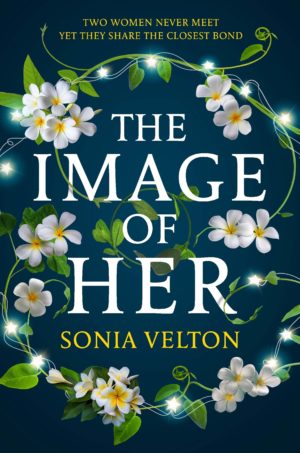You have no items in your cart. Want to get some nice things?
Go shopping
Sonia Velton’s second book, The Image of Her, is released today by Quercus. It is a contemporary suspense novel about two women who never meet yet share the closest bond. Stella and Connie live completely different lives, thousands of miles apart, but they share a poignant, and totally unexpected, common destiny.
Sonia trained as a solicitor and worked as a discrimination lawyer before relocating to Dubai. Eight years and three children later, Sonia returned to the UK where she now writes full time, alongside looking after her children.
In this feature, Sonia discusses the path that led her to writing and why, after an historical debut, she felt compelled to switch genres and tell Stella and Connie’s remarkable story.

1. Flashbulbs
Do you remember where you were when you first heard about 9/11?
I’m sure you do. It was one of those moments that become ‘flashbulb memories’ because what we are hearing is something profoundly shocking and significant. The memory becomes captured in our minds, preserved forever in perfect clarity.
I have a flashbulb memory of the moment I heard something else on the news, something that, although I didn’t know it at the time, would later become the premise of my novel The Image of Her. Unlike 9/11, this story wasn’t a global catastrophe; instead it was a very personal story about two women whose lives intertwined in a way that was both heartbreaking and awe-inspiring. You probably heard about it yourself. Perhaps you momentarily stopped what you were doing, wondering whether to be shocked, horrified, or deeply impressed, before the story became lost among a hundred others. But I couldn’t forget it. For me, the emotional impact of this story was significant enough for it to be a flashbulb moment.
I was intrigued by the thought that there could be two women – living miles apart and completely unknown to each other – who nonetheless shared an extraordinary common destiny. My novel’s protagonists, Stella and Connie, began to take shape in my mind. They were not based in any way on the lives of the women I’d heard about on the news, save that they would both, eventually, become linked by the same astonishing event.
Although the idea was very strong and compelling to me, I didn’t start actually writing the book. I was still finishing and editing my first book, Blackberry and Wild Rose, an historical fiction set in 18th century Spitalfields. How, I asked myself, could I follow up a book about Huguenot silk weavers with an achingly contemporary novel that I already knew would be part thriller, part domestic noir?
2. Write the Same, but Different
The standard advice for writers contemplating their second book is write the same, but different. I set about researching another novel set in the 18th century while secretly despising myself for not writing the book I felt passionate about. It wasn’t just that I wanted to change genre from historical to contemporary fiction, it was that my idea was a little… well, outré. What happened to these women made headlines, after all, so it had to be something pretty extreme. I found it completely fascinating, but I knew that others might find it disturbing. Should I play it safe and write the same, but different, or take a risk and write the story that was in my heart?
There was another time in my life when I was faced with a similar dilemma. I trained as a solicitor in a big city law firm, qualifying into its banking department. I absolutely hated it. I was completely uninterested in transactional law and international finance and couldn’t relate to corporate life and the macho culture of all-nighters. I left to join a much smaller firm that had just set up a Human Rights and Discrimination Unit in the wake of the Human Rights Act. A few years later I had established myself as an employment and discrimination lawyer, working in a field of law that inspired me. Was it perfect? No. Did I still sometimes feel bored and unfulfilled? Yes. But not for a minute did I ever regret doing what felt right for me rather than what made sense on paper.
And what is true of the law is surely doubly true of the creative arts, so I pitched my outré idea for a contemporary novel to my agent, then editor. There was surprise, maybe even a little shock, then enthusiasm and the most wonderful support and encouragement.
3. The Lost Decade
My legal career ground to a halt for two reasons. First, I became pregnant, and second we relocated to Dubai for my husband’s work. Two more children followed. Perhaps unsurprisingly, I found that there was not a huge amount of work in Dubai for a discrimination lawyer used to acting for individuals and trade unions. Before I knew it, I hadn’t formally worked for over 10 years. At the time I remember reading about Japan’s ‘Lost Decade,’ a prolonged period of economic stagnation. I kind of felt that this was my Lost Decade. I’m not sure where it went, it just seemed to disappear in an endless cycle of pregnancy and breastfeeding, broken up with playdates and pedicures. I’m not saying I didn’t enjoy it – it was a huge privilege to be able to have a career break to look after my young children, after all – just that I didn’t get much work done!
Before I left for Dubai, I’d done a 10-week creative writing course and started writing a novel inspired by the exquisite Spitalfields silks designed by Anna Maria Garthwaite that I’d seen in the V&A. I hadn’t got very far with it, but I picked it up again during this period of extended maternity leave. I wrote and rewrote it around nap times and school runs. Hid it away, paralysed by self-doubt. Then rewrote it again.
It’s a little ironic that just when I was trying to focus on my first novel, something was about to happen that – totally unbeknownst to me at the time – would inspire one of the central themes of my second book, The Image of Her.
It’s common in the Middle East for families to employ migrant domestic workers to help with childcare and around the house. One day our ‘housemaid,’ Imie, flew through the door in a very agitated state and proceeded to tell me that another Filipina living a few doors down was being abused by her employer. They had stolen her passport, she said. Her friend had not been paid her salary and was forced to live on scraps of food. It was heartbreaking to hear about, not least because I didn’t know what I could, or even should, do. If I tried to help I risked behaving like a ‘white saviour,’ but if I didn’t, who else would stand up for this girl trapped in a terrible situation by the kafala system, which ties the migrant worker’s visa to her employment by a local sponsor. No job means no visa, so no wonder these women can’t complain when they suffer abuse at the hands of their employer.
I decided to find out more and came across a Human Rights Watch report on migrant domestic workers in the Middle East. I dreamed of working for Human Rights Watch or a charity or NGO which helped these women. In the end, none of these things happened, and Imie helped her friend, not me. Then, years later, when I was back living in the UK and writing The Image of Her, I was thinking how I could make Connie’s life as different to Stella’s as possible. I wanted Connie to have a life that appeared charmed and glamorous. The kind of life that Stella, still living in suburbia with her mother, might see on social media and envy but which in reality would be a far darker and more sinister existence. In the middle of a run (when I seem to have all my best ideas), it all fell into place: Connie would live in Dubai.
4. The Seven Sins of Memory
Apparently, in a public address some time after 9/11, President Bush said he remembered watching the first plane hit the World Trade Center. In fact, he was visiting a school in Florida, and the plane’s impact wasn’t filmed live, so how could this be? Bush had created a false memory of actually seeing the plane hit. Overloaded by images and information about the event, his brain had struggled to distinguish between what he saw firsthand and what he had seen in film footage that emerged shortly after the event. It’s not actually true that flashbulb memories are preserved forever in perfect clarity. Even if you think your own memory of hearing about 9/11 is completely accurate, the chances are that it isn’t. It has faded over time or become confused with snippets of other recollections that have no right to be there.
The fallibility of memory has always fascinated me. Blackberry and Wild Rose is narrated in alternating chapters by the mistress and maid of the silk-weaving household. I used this format to illustrate how even if two people are in the same room, having the same experiences, their perceptions can still be very different. In The Image of Her, Stella frames her memories of the events leading up to her catastrophic accident by reference to The Seven Sins of Memory (as described by Daniel Schacter in his book of the same name), acknowledging how flawed and unreliable they are. Not pristine recollections of fact but rather something she has constructed in her own mind, influenced by bias, muddled with other experiences, or simply a phantom, a memory grown purely from the seed of suggestion.
Now that I think about it, that flashbulb memory I have – where I’m listening, astounded, to the news – can’t be true. I’m in a room in my house, and I didn’t move there until after the story broke. So maybe this memory is of the moment I thought of the idea for the book, not the moment I heard the story on the news. Perhaps it’s the sin of misattribution: the memory is correct, it’s just that the source is wrong. But it doesn’t matter, because I don’t need to make perfect sense of my memories any more than Stella needs to make sense of hers, because ultimately The Image of her isn’t a book about looking back, it’s about moving forward. It’s about understanding what makes us who we are, however imperfect that may be, in order to become the person we want to be.






